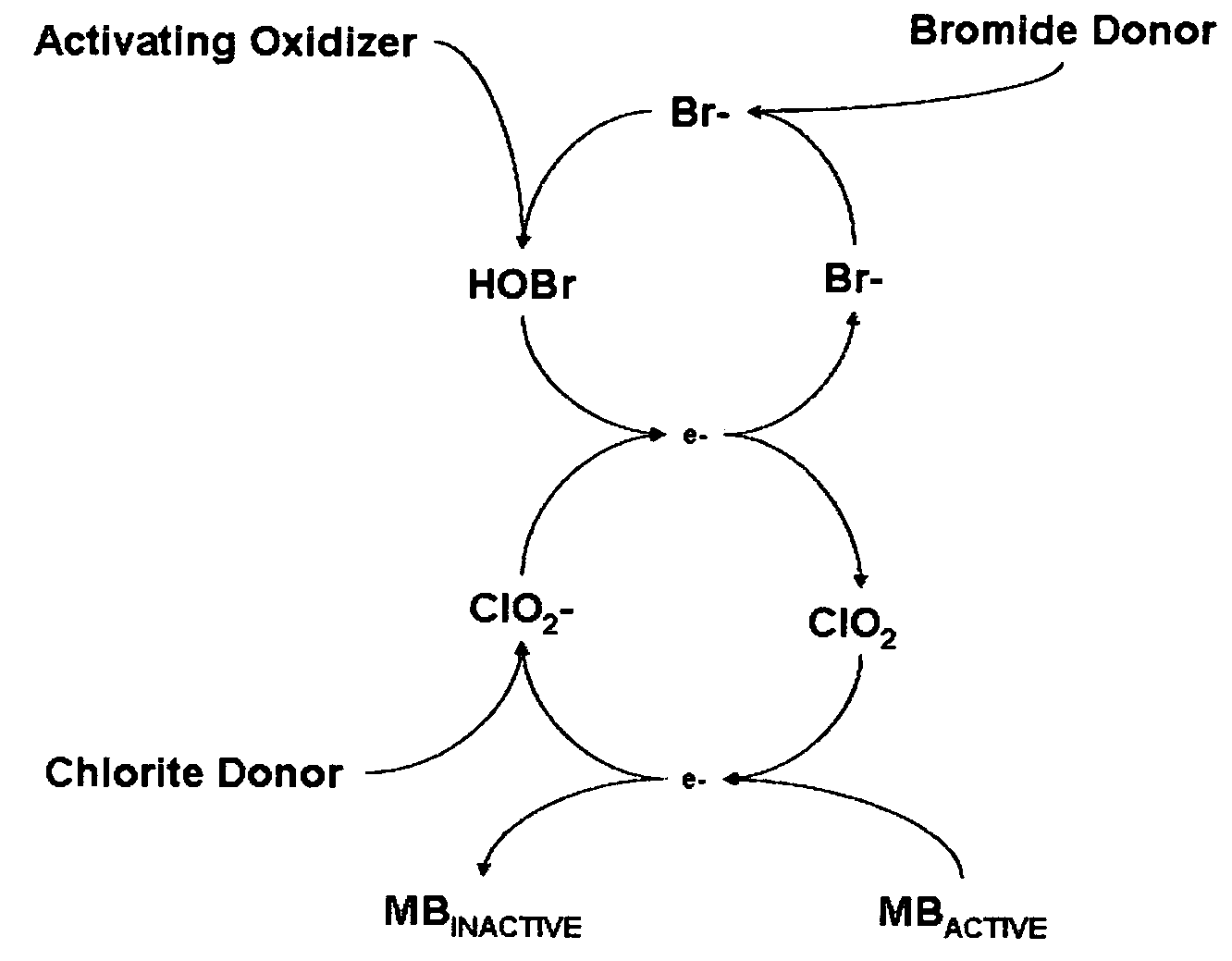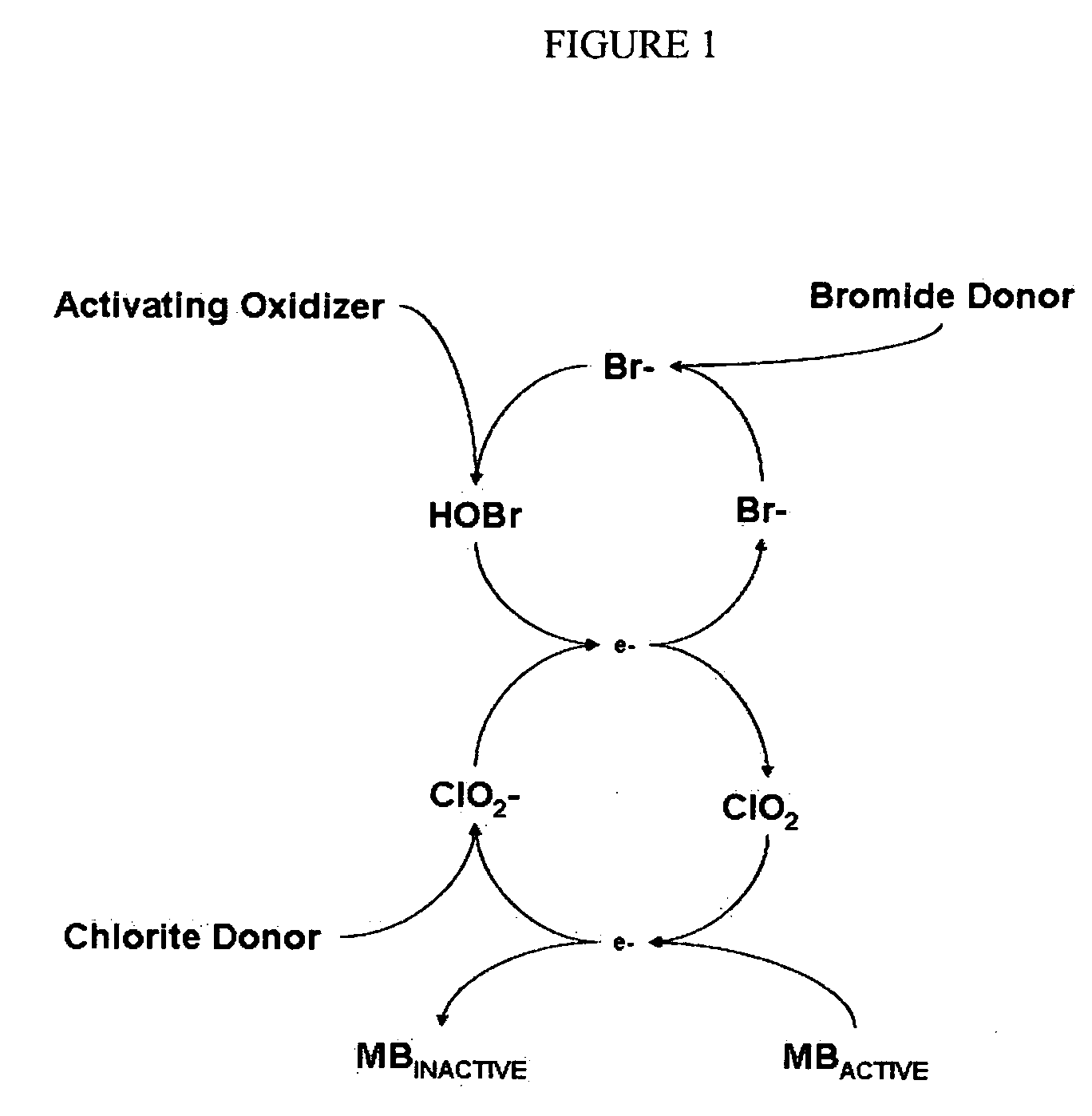Cyclic process for the efficient generation of chlorine dioxide in dilute solutions
a technology of chlorine dioxide and dilute solution, which is applied in the direction of halogen oxide/oxyacid, other chemical processes, water softening, etc., can solve the problems of not being able to effectively regenerate chlorite anions and the prior use of chlorine dioxide, so as to achieve the effect of effectively maintaining the desired concentration of chlorine dioxide, reducing the cost of chlorine dioxide production, and reducing the use of chlorine dioxid
- Summary
- Abstract
- Description
- Claims
- Application Information
AI Technical Summary
Benefits of technology
Problems solved by technology
Method used
Image
Examples
example 1
[0107]To 3500 ml Tap Water comprising Chicago City Water 200 μl of Clorox bleach comprising 6% NaOCl was added while mixing, followed by 2.5 ppm of chlorite as ClO2−. The pH was adjusted as need using NaHSO4. Total free halogen measured using DPD methods. After 10 minutes of mixing, the chlorine dioxide concentration was measured using the Chlorophenol Red method and a Hach Spectrophotometer. After the first chlorine dioxide determination using only free chlorine to activate the chlorite, incremental dosages of bromide ions were added and mixed using a magnetic stirrer, with measurements of chlorine dioxide taken between incremental additions.
Lapsed TimeBr—DPDORP(min)(ppm)as Cl2ClO2pH(mV)10 04.20.007.4571625 5n / a0.337.4774140104.20.437.467445520n / a0.457.407507044n / a0.527.43754
example 2
[0108]To 3500 ml Tap Water comprising Chicago City Water 44 ppm as Br— was added and mixed using a magnetic stirrer, followed by 200 μl of Clorox bleach comprising 6% NaOCl, and 3.75 ppm of chlorite as ClO2−. The pH and Free Halogen measured as Cl2 using DPD method were adjusted as needed to sustain desired targeted ranges. Chlorine dioxide was determined using the Chlorophenol Red method and a Hach Spectrophotometer. This method was employed to remove the interferences encountered by Glycine / DPD methods due to the presence of higher concentrations of hypobromous acid.
Lapsed TimeORPClO2(min)pH(mV)DPD as Cl2(ppm)307.427473.400.73657.437533.400.701207.477553.400.581357.487664.800.701807.537685.000.571957.38770n / a0.633307.477784.600.5612407.308264.400.24
example 3
[0109]To determine the effect of chlorite anion concentration on ORP and chlorine dioxide concentrations using the hypobromous acid system, To 3500 ml Tap Water comprising Chicago City Water 44 ppm as Br— was added and mixed using a magnetic stirrer, followed by 200 μl of Clorox bleach comprising 6% NaOC1. Varying concentration of chlorite anions was added to each test beaker. DPD method was used to determine free halogen measured as Cl2, while chlorine dioxide was determined using the Chlorophenol Red method and a Hach Spectrophotometer.
ClO2—Br—(ppm)DPD as(ppm)(Chlorite)pHCl2ORPClO2440.67.463.88770.17441.257.403.47810.29442.57.413.27650.50443.757.423.47470.73
PUM
| Property | Measurement | Unit |
|---|---|---|
| concentration | aaaaa | aaaaa |
| pH | aaaaa | aaaaa |
| concentrations | aaaaa | aaaaa |
Abstract
Description
Claims
Application Information
 Login to View More
Login to View More - R&D
- Intellectual Property
- Life Sciences
- Materials
- Tech Scout
- Unparalleled Data Quality
- Higher Quality Content
- 60% Fewer Hallucinations
Browse by: Latest US Patents, China's latest patents, Technical Efficacy Thesaurus, Application Domain, Technology Topic, Popular Technical Reports.
© 2025 PatSnap. All rights reserved.Legal|Privacy policy|Modern Slavery Act Transparency Statement|Sitemap|About US| Contact US: help@patsnap.com


